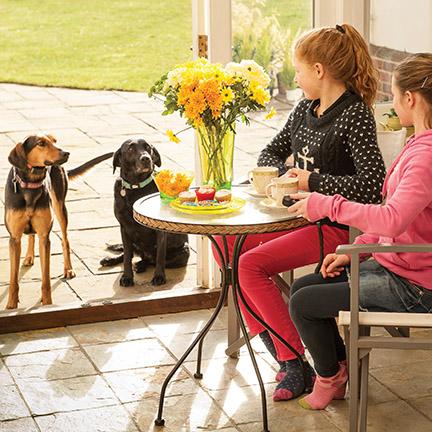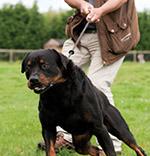(Family Features) There’s a reason why they are called fur babies. From tiny puppies to large hounds, Americans take serious pride in canine family members. In fact, according to the American Society for the Prevention of Cruelty to Animals (ASPCA) there are about 70–80 million dogs in homes across the country. And although they may be a more-than-welcome addition to the family, they may not receive such a warm welcome from the neighborhood — leaving owners to wonder what might be causing some hairs to stick up on end. The answer could be simple: poor social etiquette.
No one likes to consider their dog as a source of disruption in the community. While enjoying relaxing evening walks together or playing in the backyard, people may never consider the behavior of their dog to be a problem, especially if its disposition is friendly around people. But if watched closely, they may notice he or she is coming across as a nuisance — meaning it might be time to correct behavioral issues such as barking, jumping or not staying when instructed.
If you feel like your little pup could cause a commotion in the neighborhood, don’t fret! There are tools and steps to follow that will help take your dog from bothersome to beloved.
Barking
Oftentimes, the most disruptive action by a dog is also the hardest to control: barking. From sounding the alarm to separation anxiety, dogs use barking as an alert system. But it also is known as one of the most common causes for frustration among neighbors. To get barking under control, consider the following training tips:
-
First, identify the factors surrounding your dog’s barking. Is it more common during the day or at night? Are there triggers nearby such as people, animals or machines? According to the ASPCA, some barking issues can be resolved by removing problematic objects or noises. If the problem can’t be fixed by removing objects, have your dog checked to make sure that he or she isn’t suffering from a health issue.
-
Using tools and proper training together is often the best way to bring barking under control. Products that feature audible deterrents are oftentimes a good way to stop incessant yapping from a dog. Tools like the First Alert™ Bark Genie Automatic Ultrasonic Bark Deterrent use safe, pet-friendly ultrasonic technology that detects barking and emits sound to help control it.
-
To efficiently handle a barking problem, be sure to begin correctly training your dog while using a bark deterrent. First, never encourage or reward a dog for barking. If your dog barks compulsively, try “quiet” training. Allow the dog to bark initially, then instruct him or her to “quiet” and hold its snout for a few seconds. If the dog remains quiet after you let go, give it a treat as a reward. Not all dogs are the same, so training bark control can be difficult. However, with enough positive reinforcement used with training aids like the Bark Genie, excessive barking can be quelled.
Jumping
Does your dog jump on strangers? If instructed to stop, does he or she listen? Jumping and tackling can be perceived as aggressive behaviors and can give off the appearance that you might not have complete control of your dog. However, unlike barking, bouncing or jumping is even more controllable by training. If the problem exists with your pup, the ASPCA provides the following tips to correct the problem:
-
In order to successfully train your dog to interact with other people, you need to train him or her one-on-one first. When greeted by your jumping dog, keep calm. The more excited you are, the more excited your dog will be. If it begins to jump, do not reach out to pet or stroke the dog. Instead, keep your eyes raised to avoid eye contact and keep your arms and hands away until the dog keeps its front feet on the ground.
-
Once the canine has calmed and is standing on four feet, immediately reach out to show affection. This will emphasize the importance of staying down when greeting. If the dog becomes excited and begins jumping again, restart the process.
-
If initial training tips don’t help, or if training takes a while, it’s important to keep your dog on a short leash while interacting with other people. Products like comfortable no-jump dog harnesses work well in keeping control over your pup and will help other people feel more comfortable around your dog. In addition, always keep treats on hand to encourage your dog to stay calm and by your side.
Staying
If your dog doesn’t have a jumping or barking problem, he might have a problem with running free. Between the front yard, backyard and entire neighborhood, there’s just so much to see! But this can be extremely invasive and bothersome to other neighbors. If your dog commonly attempts to break free during a walk or run, or tries to get loose from the yard or house, try the following steps to control the behavior:
-
According to the ASPCA, the hardest to achieve but most effective training tip to control your dog when it attempts to run or chase is establishing a call that works. To train your dog, simply practice the specific call repeatedly for as long as it takes until the dog begins to adapt. Each time you make the call toward your dog, reward him or her with a treat to set firm expectations that coming when called is a positive thing. Try practicing this training exercise while on a walk. If your dog begins to wander, simply pat your legs and call it for a treat to set expectations that your dog should stick close to you when outside. Keeping a training tool with you can also be handy in case your dog decides to ignore a command or call. Using a tool like the First Alert™ Bark Genie Handheld Ultrasonic Bark Deterrent utilizes the same pet-friendly technology and allows for more precise training control over your dog.
-
If your dog is attempting to break free from an enclosed area such as a backyard, ensure that your fence is an appropriate height, that there are no gaps in the fence and that your dog isn’t prone to digging to escape. Practice the same training tips to calmly control your dog and remember — it might take some time!
-
If nothing else works, and if time allows, tire out your pup with extensive play time! An under stimulated dog can get extremely antsy, but enough activity will help to reduce the urge to break free when out in public. You’ll have a good time, and your pup will too.
First Alert for Pets Bark Genie™ products are available at Walmart stores nationwide. For more information, visit www.firstalertforpets.com.
Photos courtesy of Getty Images (dog on leash and dog at door)
SOURCE:
First Alert


